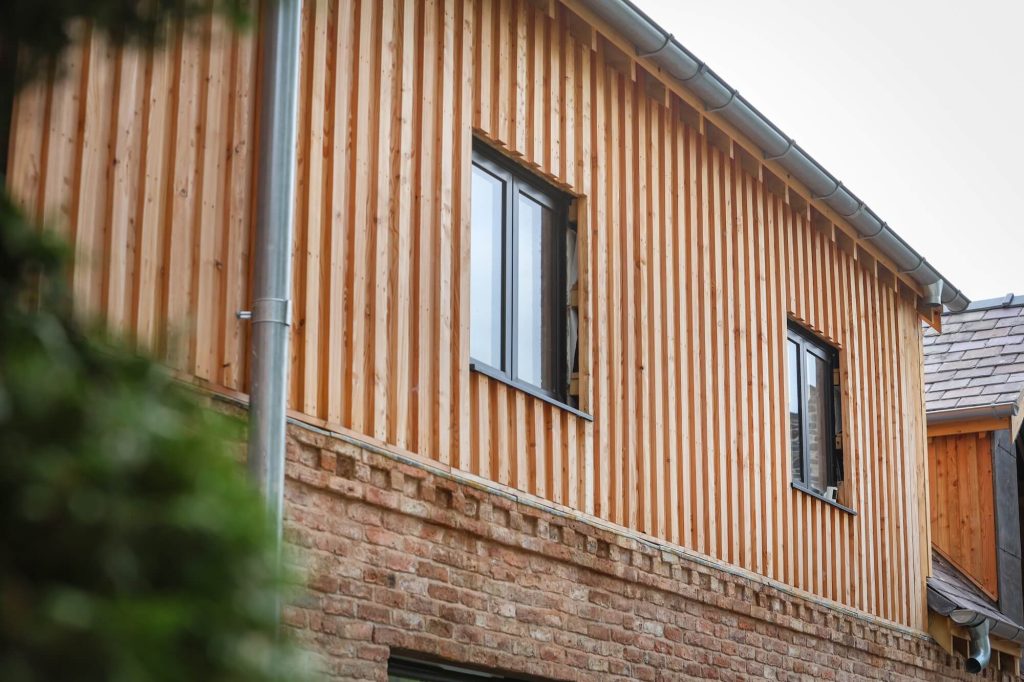Timber has long been a favoured material for building and design, admired for its natural beauty, versatility, and sustainability. Over the years, timber cladding has evolved, combining traditional techniques with contemporary aesthetics to suit modern architectural needs. Timber batten cladding showcases this evolution, providing a sleek, modern look while preserving the warmth of natural wood.
This blog explores the benefits, applications, and considerations of using timber batten cladding, making it an ideal choice for both residential and commercial projects.

What is Timber Batten Cladding?
Timber batten cladding is a type of exterior cladding that features narrow, vertically or horizontally aligned timber slats, typically fixed with spacing between each batten. The design creates a clean, linear look that enhances the appearance of any building. It is often used for both functional and decorative purposes, providing protection while adding an architectural statement.
Benefits of Timber Batten Cladding
Aesthetic Appeal
Timber batten cladding is highly versatile in its visual appeal. It can be arranged to create sharp, clean lines for a minimalist aesthetic or combined with natural finishes for a rustic, organic look. The spacing between battens adds texture and depth, allowing light and shadows to play across the surface, creating dynamic visual effects.
Sustainability
Sustainably sourced timber, such as larch, cedar, or Douglas fir, is an environmentally friendly choice for cladding. When managed responsibly, timber production promotes biodiversity, reduces carbon emissions, and supports renewable resources. Opting for FSC® (FSC-C134890) certified timber ensures eco-consciousness throughout the project.
Durability
Timber batten cladding, especially when made from naturally durable species like larch or cedar, offers excellent resistance to weather and decay. Proper treatment and maintenance further enhance its longevity, making it a reliable option for exterior applications.
Versatility
Whether for residential homes, commercial buildings, or public spaces, timber batten cladding adapts seamlessly to different architectural styles. It can be used to highlight specific sections of a building, create privacy screens, or even serve as a feature wall indoors.

Ventilation
The spacing between the battens allows for natural ventilation, reducing moisture build-up and improving the cladding’s performance. This feature makes it particularly suitable for climates with varying weather conditions.
Popular Timber Choices for Batten Cladding
Larch
Larch is a durable, cost-effective option that resists rot and decay naturally. Its warm tones and fine grain make it a popular choice for both traditional and modern designs.
Cedar
Cedar is celebrated for its lightweight, resistance to pests, and beautiful reddish-brown hues. It weathers gracefully, developing a silvery patina over time if left untreated.
Douglas Fir
Douglas fir combines strength and beauty, making it suitable for structural and decorative applications. It’s light colour and straight grain lend a contemporary feel to any design.
Applications of Timber Batten Cladding
Residential Properties
Timber batten cladding is widely used in residential settings to improve the exterior of the property, provide insulation, and create a unique design feature. It’s often applied to facades, garden walls, and outdoor seating areas.
Commercial Buildings
In commercial architecture, batten cladding is used to add a touch of sophistication. Retail outlets, offices, and public buildings use it to create a striking yet inviting exterior.
Interior Design
The versatility of timber batten cladding extends indoors. It can be used for feature walls, room dividers, and ceiling panels, offering a natural, warm finish that complements modern interiors.
Privacy Screens
Timber battens are a popular choice for creating privacy screens in gardens, patios, and balconies. Their spacing offers seclusion while still allowing light and airflow.

Installation Considerations
Design Flexibility
Timber batten cladding allows for various installation patterns, including vertical, horizontal, and diagonal arrangements. Consider the architectural style of your building when selecting the orientation and spacing.
Proper Fixing
To maximise durability, use stainless steel or galvanised fixings that resist rust and corrosion. Secure the battens to a durable framework to prevent warping and ensure stability.
Treatment and Maintenance
Applying protective treatments such as oils, stains, or sealants enhances the timber’s resistance to UV rays, moisture, and pests. Regular cleaning and reapplication of treatments help maintain the cladding’s appearance and performance over time.
Ventilation and Drainage
Proper ventilation and drainage are critical for preventing moisture retention. Ensure there is sufficient airflow behind the cladding and that water is directed away from the structure.
Why Choose The Larch Cladding Company
At The Larch Cladding Company, we are passionate about providing high-quality, sustainably sourced timber products. Our range of larch, cedar, and Douglas fir cladding is perfect for creating stunning batten designs that blend traditional craftsmanship with modern aesthetics.
We offer bespoke cutting services, tailored to meet the unique requirements of your project. Whether you need precise dimensions or specific finishes, our team is here to help. With nationwide delivery and expert guidance, we ensure that your timber cladding project is a success from start to finish.
Contact Us
Ready to explore the possibilities of timber batten cladding? Contact The Larch Cladding Company today by calling 01352 746293 or emailing info@thelarchcladdingcompany.co.uk.

